Статьи журнала - International Journal of Image, Graphics and Signal Processing
Все статьи: 1056
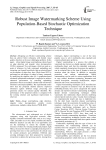
Robust Image Watermarking Scheme Using Population-Based Stochastic Optimization Technique
Статья научная
Designing an efficient watermarking scheme that can achieve better robustness with limited visual quality distortion is the most challenging problem. In this paper, robust digital image watermarking scheme based on edge detection and singular value decomposition (SVD) is proposed. Two sub-images, which are used as a point of reference for both watermark embedding and extracting, are formed from blocks that are selected based on the number of edges they have. Block based SVD is performed on sub-images to embed a binary watermark by modifying the singular value (S). A population-based stochastic optimization technique is employed to achieve enhanced performance by searching embedding parameters which can maintain a better trade-off between robustness and imperceptibility. The experimental results show that the proposed method achieves improved robustness against different image processing and geometric attacks for selected quality threshold. The performance of the proposed scheme is compared with the existing schemes and significant improvement is observed.
Бесплатно
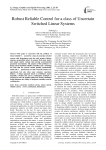
Robust Reliable Control for a class of Uncertain Switched Linear Systems
Статья научная
This paper is concerned with the problem of robust reliable H∞ control for a class of uncertain switched systems with disturbances and also with actuator failures among a prespecified subset of actuator. Both state matrix and output matrix contain time-varying norm-bounded parameter uncertainties. The purpose of this problem is to design robust feedback-reliable controllers and a switching law such that the systems remain globally quadratically stable and H∞ performance not only when all actuators are operational, but also when some actuators experience failures. A design approach based on LMI(linear matrix inequality) method and convex combination technique is proposed to solve the problem addressed. Finally, simulation results illustrate the validity of designed controllers and the switching law.
Бесплатно
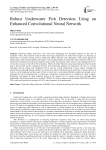
Robust Underwater Fish Detection Using an Enhanced Convolutional Neural Network
Статья научная
Underwater Object Detection is one of the most challenging and unexplored domains in this area of Computer Vision. The proposed research refines the image enhancement of under-water imagery by proposing an improvement of already existing tools for underwater Object detection. The comparative study clearly depicts the enhancement of the proposed method with respect to the existing methods for underwater object detection. Moreover, a framework for detection of underwater organisms such as fishes are proposed, which will act as the steppingstone for re- serving the ecosystem of the whole fish community. Mostly the object detection using deep learning has been the prime goal to this research and the comparison between other preexisting methods are compared at the end. As a result, techniques that are already well established will be used for overall enhancement of those images. Through this enhancement and through finding a healthy environment for their breeding ground, the extinction of selected species of fishes is can be diminished and decreased. All this is carried out by overcoming difficulties underwater through a novel technique that can be integrated into an Underwater Autonomous Vehicle and can be classified as robust in nature. Robustness will depend on three important factors in this research, first is accuracy, then fast and lastly being upgradeable. The proposed method is a modified VGGNet-16, which is trained using the ImageCLEF FISH_TS dataset. The overall result provides an accuracy of 96.4% which surpasses all its predecessors.
Бесплатно
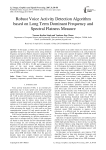
Статья научная
In this paper, a robust voice activity detection algorithm based on a long-term metric using dominant frequency and spectral flatness measure is proposed. The propose algorithm makes use of the discriminating power of both features to derive the decision rule. This method reduces the average number of speech detection errors. We evaluate its performance using 15 additive noises at different SNRs (-10 dB to 10 dB) and compared with some of the most recent standard algorithms. Experiments show that our propose algorithm achieves the best performance in terms of accuracy rate average over all SNRs and noises.
Бесплатно
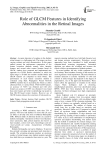
Role of GLCM Features in Identifying Abnormalities in the Retinal Images
Статья научная
Accurate detection of exudates in the diabetic retinal images is a challenging task. The images can have varying contrast and color characteristics. In this paper authors present the performance comparison of two feature extraction methods namely color intensity features and second order texture features based on GLCM. Authors have proposed and implemented new approach for GLCM feature calculation in which the input image is divided into number smaller blocks and GLCM features are computed on these blocks. The performance of each feature extraction method is evaluated using Back Propagation Neural Network (BPNN) classifier that is classifying the blocks as either abnormal block or normal block. With GLCM features, an accuracy of 76.6% was obtained and with color features an accuracy of 100% was obtained. It was found that color features are better in identifying true positives than GLCM based texture features. However use of GLCM features reduces the occurrence of false positives.
Бесплатно
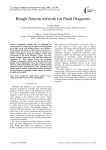
Rough Neuron network for Fault Diagnosis
Статья научная
Considering training time of traditional BP neural network is too long and it cannot solve the problems in the input vector with multiple-valued, a new method of BP neural network based on rough neuron is presented. A rough neuron can be viewed as a pair of neurons. One neuron corresponds to the upper boundary and the other corresponds to the lower boundary. Upper and lower neuron exchange information with each other during the calculation of their outputs. Firstly, the continuous attributes in diagnostic decision system are discretized with particle swarm optimization. Then, the reducts are found based on attribute dependence of rough set, and the optimal diagnostic decision is determined. Lastly, according to the optimal decision system, rough neuron network is designed for fault diagnosis. A practical example is given , the method is feasible and available.
Бесплатно
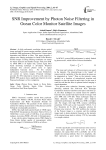
SNR Improvement by Photon Noise Filtering in Ocean Color Monitor Satellite Images
Статья научная
In high radiometric resolution electro optical image payloads of remote sensing satellites, photon noise dominates SNR performance. Photon noise is input signal dependent and difficult to filter. This paper proposes a photon noise filtering technique for Ocean Color Monitor (OCM) images. Existing filtering techniques are meant for object detection and handles images with poor SNR. As OCM SNR is on higher side, custom sigma filter based denoising technique is developed. Proposed technique first converts photon noise to signal independent Gaussian noise. For this variance stabilization, Anscombe transform is used. Simulations are carried on various images. Proposed technique provides 20- 50% reduction in overall as well count-wise RMSE. FFT analysis shows significant reduction in noise. Proposed technique is of low complexity.
Бесплатно
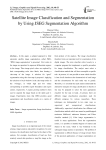
Satellite Image Classification and Segmentation by Using JSEG Segmentation Algorithm
Статья научная
In this paper, a adopted approach to fully automatic satellite image segmentation, called JSEG, "JPEG image segmentation" is presented. First colors in the image are quantized to represent differentiate regions in the image. Then image pixel colors are replaced by their corresponding color class labels, thus forming a class-map of the image. A criterion for “good” segmentation using this class-map is proposed. Applying the criterion to local windows in the class-map results in the “J-image”, in which high and low values corresponding to possible region boundaries and region centers, respectively. A region growing method is then used to segment the image based on the multi-scale J-images. Experiments show that JSEG provides good segmentation and classification results on a variety of images.
Бесплатно
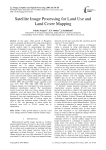
Satellite Image Processing for Land Use and Land Cover Mapping
Статья научная
In this paper, urban growth of Bangalore region is analyzed and discussed by using multi-temporal and multi-spectral Landsat satellite images. Urban growth analysis helps in understanding the change detection of Bangalore region. The change detection is studied over a period of 39 years and the region of interest covers an area of 2182 km2. The main cause for urban growth is the increase in population. In India, rapid urbanization is witnessed due to an increase in the population, continuous development has affected the existence of natural resources. Therefore observing and monitoring the natural resources (land use) plays an important role. To analyze changed detection, researcher’s use remote sensing data. Continuous use of remote sensing data helps researchers to analyze the change detection. The main objective of this study is to monitor land cover changes of Bangalore district which covers rural and urban regions using multi-temporal and multi-sensor Landsat - multi-spectral scanner (MSS), thematic mapper (TM), Enhanced Thematic mapper plus (ETM+) MSS, TM and ETM+ images captured in the years 1973, 1992, 1999, 2002, 2005, 2008 and 2011. Temporal changes were determined by using maximum likelihood classification method. The classification results contain four land cover classes namely, built-up, vegetation, water and barren land. The results indicate that the region is densely developed which has resulted in decrease of water and vegetation regions. The continuous transformation of barren land to built-up region has affected water and vegetation regions. Generally, from 1973 to 2011 the percentage of urban region has increased from 4.6% to 25.43%, mainly due to urbanization.
Бесплатно
Scale Adaptive Object Tracker with Occlusion Handling
Статья научная
Real-time object tracking is one of the most crucial tasks in the field of computer vision. Many different approaches have been proposed and implemented to track an object in a video sequence. One possible way is to use mean shift algorithm which is considered to be the simplest and satisfactorily efficient method to track objects despite few drawbacks. This paper proposes a different approach to solving two typical issues existing in tracking algorithms like mean shift: (1) adaptively estimating the scale of the object and (2) handling occlusions. The log likelihood function is used to extract object pixels and estimate the scale of the object. The Extreme learning machine is applied to train the radial basis function neural network to search for the object in case of occlusion or local convergence of mean shift. The experimental results show that the proposed algorithm can handle occlusion and estimate object scale effectively with less computational load making it suitable for real-time implementation.
Бесплатно
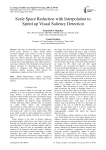
Scale Space Reduction with Interpolation to Speed up Visual Saliency Detection
Статья научная
The scale of salient object in an image is not a known priori, therefore to detect salient objects accurately multiple scale analysis is used by saliency detection models. However, multiple scale analysis makes the saliency detection slow. Fast and accurate saliency detection is essential to obtain Region of Interest in image processing applications. This paper proposes a scale space reduction with interpolation to speed up the saliency detection. To demonstrate the concept, this method is integrated with Hypercomplex Fourier Transform saliency detection which reduced the computational complexity from O(N) to O(N/2).
Бесплатно
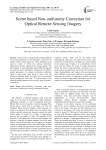
Scene based non-uniformity correction for optical remote sensing imagery
Статья научная
In this work, we propose and evaluate different scene based methods for non-uniformity corrections for optical remote sensing data sets. These methods can be used to correct or refine the existing radiometric calibrations, thereby improving the image quality. The performance of each algorithm against different datasets are analyzed and a quantitative comparison of different quality parameters viz. entropy, correlation coefficient, signal to noise ratio, peak signal to noise ratio and structural similarity index are carried out to recommend the best method for each scene. For a given data set, the selected method depends on the severity, type of terrain it covered, etc.
Бесплатно
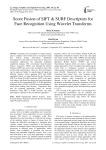
Score Fusion of SIFT & SURF Descriptors for Face Recognition Using Wavelet Transforms
Статья научная
Automatic face recognition is a major research area in computer vision which aims to recognize human face without human intervention. Significant developments in this field have shown that in many face recognition applications the automated techniques outperform humans. The conventional Scale-Invariant Feature Transform (SIFT) and Speeded-Up Robust Features (SURF) are used in face recognition where they provide high performances. However, this performance can be improved further by transforming the input into different domains before applying SIFT and SURF algorithms. Hence, we apply Discrete Wavelet Transform (DWT) or Gabor Wavelet Transform (GWT) at the input face images, which provides denser and extra information to be used by the conventional SIFT or SURF algorithms. Matching scores of SIFT or SURF from each subimage is fused before making final decision. Simulations show that the proposed approaches based on wavelet transforms using SIFT or SURF provides very high performance compared to the conventional algorithms.
Бесплатно
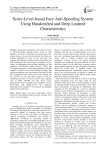
Score-level-based face anti-spoofing system using handcrafted and deep learned characteristics
Статья научная
Recognition performance of biometric systems is affected through spoofing attacks made by fake identities. The focus of this paper is on presenting a new scheme based on score level and decision level fusion to monitor individuals in term of real and fake. The proposed fake detection scheme involve consideration of both handcrafted and deep learned techniques on face images to differentiate real and fake individuals. In this approach, convolutional neural network (CNN) and overlapped histograms of local binary patterns (OVLBP) methods is used to extract facial features of images. The produced matching scores provided by CNN and OVLBP then combined to form a fused score vector. Finally, the last decision on real and attack images is done by combining decisions of hybrid scheme using majority vote of CNN, OVLBP and their fused vector. Experimental results on public spoof databases such as Print-Attack and Replay-Attack face databases demonstrate the strength of the proposed anti-spoofing method for fake detection.
Бесплатно
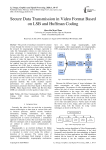
Secure Data Transmission in Video Format Based on LSB and Huffman Coding
Статья научная
The growth of needing to transmit bit amount of data through the internet in secure format encourage the research for steganography technique, especially in video file. Stenographic technics in video format gives many advantages to transportation of important data because video files are a part of people’s daily life and the attackers can’t notice easily. The high embedding capacity of video file improves the popularity of video steganography among the various media types. Therefore, the simplest form but with many advantage of (Least significant bit) LSB, that is enforced with the high compression method of Huffman chunk coding method is proposed in this paper to embed data in video file in multi-step cryptography embedding schemes. The intension is to get more secure nature of the system and to get more embedding capacity system. The experiments are carried out with various sizes of video files and text file sizes are used to show the effectiveness of the proposed methods. The results manifest superior performance for proposed algorithm with the performance parameters like Peak Signal to Noise Ratio (PSNR), Mean Square Error (MSE) and Bit Error Rate (BER) are calculated to test the quality of stego video.
Бесплатно
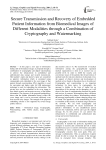
Статья научная
In this paper a new type of information hiding skill in biomedical images is proposed through a combination of cryptography and digital watermarking to achieve the enhancement in confidential and authenticated data storage and secured transmission. Here patient's name and doctor's name are considered as patient's information which is encrypted using cryptography and embedded in the scan image of that patient through watermarking. RSA algorithm is used for encryption and higher order bit LSB replacement technique is used for embedding the information. The private keys are also embedded in the cover image to have better security and accurate recovery of the hidden information. The outcome of the proposed methodology shows that the hidden information doesn't affect the cover image and it can be recovered efficiently even from several noisy images. The strength of the proposed embedding scheme is also supported by several image quality matrices.
Бесплатно
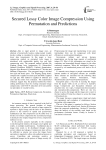
Secured Lossy Color Image Compression Using Permutation and Predictions
Статья научная
Due to rapid growth in image sizes, an alternate of numerically lossless coding named visually lossless coding is considered to reduce storage size and lower data transmission. In this paper, a lossy compression method on encrypted color image is introduced with undetectable quality loss and high compression ratio. The proposed method includes the Xinpeng Zhang lossy compression [1], Hierarchical Oriented Prediction (HOP)[2], Uniform Quantization, Negative Sign Removal, Concatenation of 7-bit data and Huffman Compression. The encrypted image is divided into rigid and elastic parts. The Xinpeng Zhang elastic compression is applied on elastic part and HOP is applied on rigid part. This method is applied on different test cases and the results were evaluated. The experimental evidences suggest that, the proposed method has better coding performance than the existing encrypted image compressions, with 9.645 % reductions in bit rate and the eye perception is visually lossless.
Бесплатно
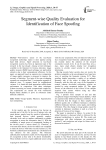
Segment-wise Quality Evaluation for Identification of Face Spoofing
Статья научная
Non-intrusive nature of the face-based recognition technology makes it more popular among hand held devices. Spoof detection in face-based recognition systems has been an important topic of the research in the last decade. Among several techniques available in the literature for liveness detection, image quality measure (IQM) based technique are particularly attractive due to their computational efficiency. In this paper, an approach based on segment-wise computation of image quality measures is proposed to improve the accuracy of detection. Two types of the non-overlapping segments are considered here: 1) rectangular segments of identical sizes, 2) segment based on neighborhood variance. It is found that both approaches exhibit better performance in comparison with other techniques without increasing too much computational complexity. The experiments are carried out with well-known Replay-Attack database to prove its robustness under different conditions.
Бесплатно
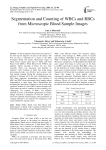
Segmentation and Counting of WBCs and RBCs from Microscopic Blood Sample Images
Статья научная
In the biomedicine field, blood cell analysis is the first step for diagnosis of many of the disease. The first test that is requested by a doctor is the CBC (Complete Blood cell Count). Microscopic image of blood stream contains three types of blood cells: Red Blood Cells (RBCs), White Blood Cells (WBCs) and platelets. Earlier counting of blood cell was done manually which was inaccurate and depends on operator's skill. Counting of blood cells using image processing provides cost effective and accurate result than manual counting. During the counting process, the splitting of clumped cell is the most challenging issue. This paper represents segmentation and counting of RBCs and WBCs from microscopic blood sample images. Segmentation is done using Otsu's thresholding and morphological operations. Counting of cells is done using geometric features of cells. RBCs contain clumped cells which make the task of counting of cells accurately very challenging. For counting of RBCs, two different methods are used: 1) Watershed segmentation 2) Circular Hough Transform. Comparison of both this method is shown for randomly selected images. The performance of counting methods is also analyzed by comparing it with results obtained by manual counts.
Бесплатно
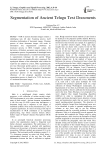
Segmentation of Ancient Telugu Text Documents
Статья научная
OCR of ancient document images remains a challenging task till date. Scanning process itself introduces deformation of document images. Cleaning process of these document images will result in information loss. Segmentation contributes an invariance process in OCR. Complex scripts, like derivatives of Brahmi, encounter many problems in the segmentation process. Segmentation of meaningful units, (instead of isolated patterns), revealed interesting trends. A segmentation technique for the ancient Telugu document image into meaningful units is proposed. The topological features of the meaningful units within the script line are adopted as a basis, while segmenting the text line. Horizontal profile pattern is convolved with Gaussian kernel. The statistical properties of meaningful units are explored by extensively analyzing the geometrical patterns of the meaningful unit. The efficiency of the proposed algorithm involving segmentation process is found to be 73.5% for the case of uncleaned document images.
Бесплатно

